Uniform Circular Motion and Gravitation
35 Rotation Angle and Angular Velocity
Learning Objectives
- Define arc length, rotation angle, radius of curvature and angular velocity.
- Calculate the angular velocity of a car wheel spin.
In earlier chapters, we studied Kinematics in straight lines and in two dimensions, like projectile motion. Now we turn to motion along curved paths. Unlike projectiles, which eventually land, we will focus on motion that continues along a curve, such as a CD spinning or a car wheel rotating.
Rotation Angle
When an object rotates around a fixed axis, every point on it follows a circular path. For example, imagine a compact disc (CD) spinning in a player. Each “pit” on a line from the center to the edge of the disc moves through the same angle at the same time (Figure 35.1). The amount of rotation is called the rotation angle and is similar to measuring a distance traveled but along a curve.
We define the rotation angle [latex]\Delta \theta[/latex] as the ratio of the arc length [latex]\Delta s[/latex] to the radius of curvature [latex]r[/latex]:
[latex]\Delta \theta = \frac{\Delta s}{r}[/latex]
-
[latex]\Delta \theta[/latex] is in radians (rad)
-
[latex]\Delta s[/latex] is the arc length (in meters)
-
[latex]r[/latex] is the radius from the axis of rotation (in meters)
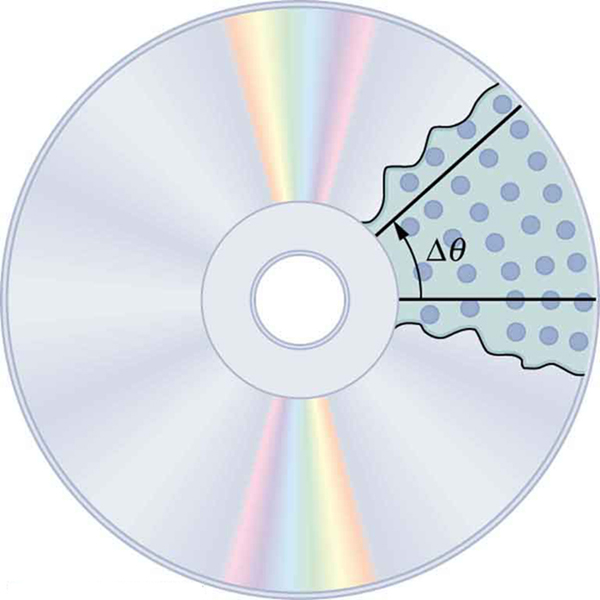
Arc Length and Radians
A radian is a unit based on the arc of a circle. One full circle has an arc length of:
[latex]\Delta s = 2\pi r[/latex]
So the total rotation angle for one complete revolution as shown in Figure 35.2 is:
[latex]\Delta \theta = \frac{2\pi r}{r} = 2\pi \text{ radians}[/latex]
This is why:
[latex]2\pi \ \text{rad} = 1 \ \text{revolution} = 360^\circ[/latex]
Thus, we can convert between radians and degrees:
[latex]1 \ \text{rad} = \frac{360^\circ}{2\pi} \approx 57.3^\circ[/latex]
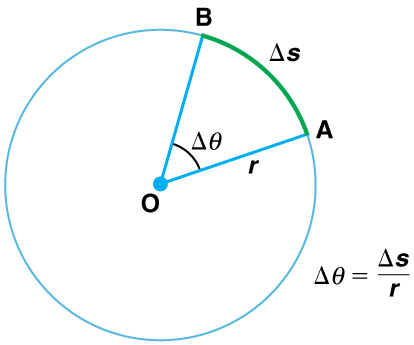
A comparison of some useful angles expressed in both degrees and radians is shown in Table 35.1
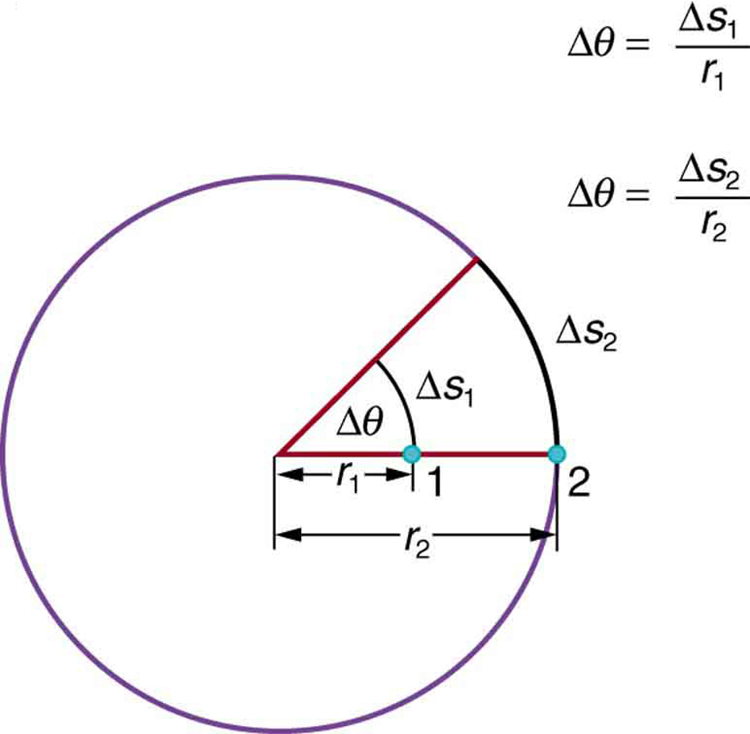
If [latex]\text{Δ}\theta =2\pi[/latex] rad, then the CD has made one complete revolution, and every point on the CD is back at its original position. Because there are [latex]\text{360º}[/latex] in a circle or one revolution, the relationship between radians and degrees is thus
so that
Angular Velocity
Just like linear velocity describes how fast an object moves in a straight line, angular velocity describes how fast something is rotating.
The average angular velocity [latex]\omega[/latex] is:
[latex]\omega = \frac{\Delta \theta}{\Delta t}[/latex]
-
Units: radians per second (rad/s)
The larger the rotation angle per time, the faster the angular velocity.
Linear and Angular Velocity Connection
Consider a point on the rim of a spinning CD or the tire of a car. It travels a certain arc length [latex]\Delta s[/latex] in time [latex]\Delta t[/latex], giving it a linear velocity:
[latex]v = \frac{\Delta s}{\Delta t}[/latex]
Since:
[latex]\Delta s = r \Delta \theta[/latex]
Substitute into the formula for linear velocity:
[latex]v = \frac{r \Delta \theta}{\Delta t} = r\omega[/latex]
So we have two equivalent relationships:
[latex]v = r \omega \quad \text{or} \quad \omega = \frac{v}{r}[/latex]
This shows:
-
Tangential (linear) speed [latex]v[/latex] increases with the radius [latex]r[/latex] if [latex]\omega[/latex] is constant.
-
A larger wheel (larger [latex]r[/latex]) spins slower to maintain the same [latex]v[/latex].
-
A faster-spinning wheel (larger [latex]\omega[/latex]) increases linear speed.
The relationship in [latex]v=\mathrm{r\omega }\text{ or }\omega =\frac{v}{r}[/latex] can be illustrated by considering the tire of a moving car. Note that the speed of a point on the rim of the tire is the same as the speed [latex]v[/latex] of the car. See Figure 35.4 So the faster the car moves, the faster the tire spins—large [latex]v[/latex] means a large [latex]\omega[/latex], because [latex]v=\mathrm{r\omega }[/latex]. Similarly, a larger-radius tire rotating at the same angular velocity ([latex]\omega[/latex]) will produce a greater linear speed ([latex]v[/latex]) for the car.
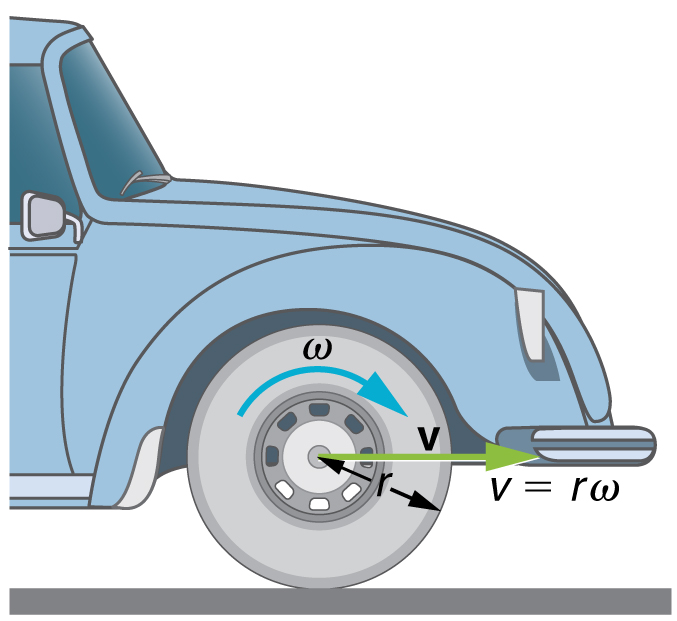
Example 35.1: How Fast Does a Car Tire Spin?
Calculate the angular velocity of a 0.300 m radius car tire when the car travels at [latex]\text{15}\text{.}0\phantom{\rule{0.25em}{0ex}}\text{m/s}[/latex] (about [latex]\text{54}\phantom{\rule{0.25em}{0ex}}\text{km/h}[/latex]). See Figure 35.4
Strategy
Because the linear speed of the tire rim is the same as the speed of the car, we have
[latex]v=\text{15.0 m/s}.[/latex]
The radius of the tire is given to be
[latex]r=\text{0.300 m}.[/latex] Knowing
[latex]v[/latex] and [latex]r[/latex], we can use the second relationship in [latex]v=\mathrm{r\omega }\mathrm{, }\omega =\frac{v}{r}[/latex] to calculate the angular velocity.
Solution
To calculate the angular velocity, we will use the following relationship:
Substituting the knowns,
Discussion
When we cancel units in the above calculation, we get 50.0/s. But the angular velocity must have units of rad/s. Because radians are actually unitless (radians are defined as a ratio of distance), we can simply insert them into the answer for the angular velocity. Also note that if an earth mover with much larger tires, say 1.20 m in radius, were moving at the same speed of 15.0 m/s, its tires would rotate more slowly. They would have an angular velocity
Direction of Angular and Linear Velocity
Just like straight-line motion has direction, rotational motion does too. Both angular velocity [latex]\omega[/latex] and linear velocity [latex]v[/latex] are vector quantities—they have both magnitude and direction.
-
Angular velocity [latex]\omega[/latex] has only two possible directions with respect to the axis of rotation:
-
Clockwise (CW)
-
Counterclockwise (CCW)
-
-
Linear velocity [latex]v[/latex] is always tangent to the circular path at any point on the rotating object. That’s why it’s also called tangential velocity.
This idea is illustrated in Figure 35.5
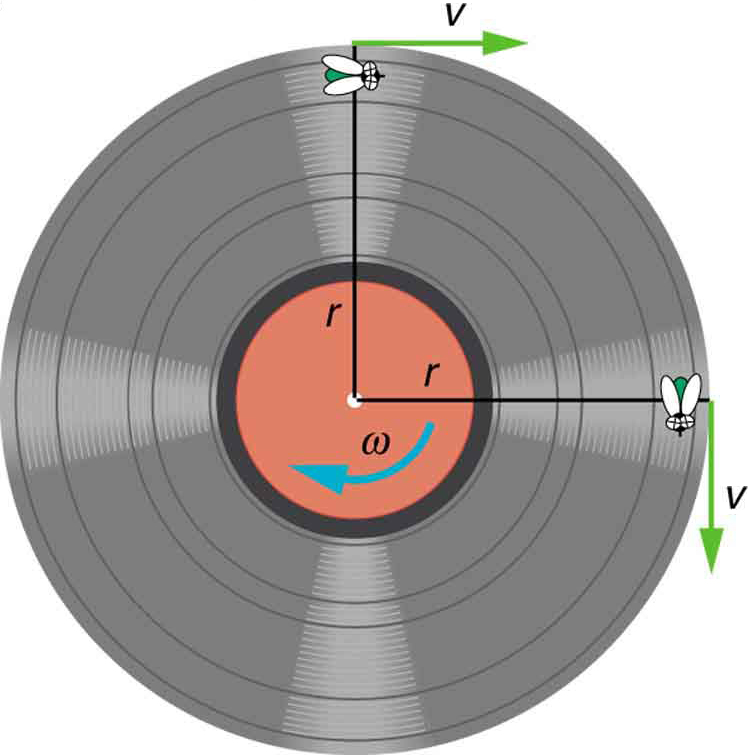
🧪 Take-Home Experiment: Measuring Angular and Linear Speed
Try this hands-on activity to connect theory with real-world motion:
-
Materials Needed:
-
A small object (e.g., a key or small ball)
-
A string about 1 meter long
-
A stopwatch or timer
-
-
What to Do:
-
Tie the object to one end of the string.
-
Swing it in a horizontal circle above your head by rotating your wrist.
-
Try to maintain a steady (uniform) speed as it spins.
-
-
Measure Angular Velocity:
-
Count how many full revolutions the object makes in, say, 10 seconds.
-
Angular velocity is:
[latex]\omega = \frac{2\pi \times \text{(number of revolutions)}}{\text{time}} \ (\text{rad/s})[/latex]
-
-
Estimate Linear Speed:
-
Measure the length of the string (this is [latex]r[/latex]).
-
Use the formula:
[latex]v = r\omega[/latex]
-
-
Try Measuring Closer In:
-
Choose a point closer to your hand (shorter radius) and repeat.
-
Notice that even with the same [latex]\omega[/latex], the linear speed [latex]v[/latex] is smaller.
-
-
Explore More:
-
Look around for other rotating objects—fans, wheels, turntables.
-
Estimate or measure their angular velocities using this same method!
-
This experiment is a simple way to see the difference between angular and linear velocity and how they relate. It also connects to biological applications like joint motion in limbs or the motion of circular cellular structures like cilia and flagella.
PhET Explorations: Ladybug Revolution
Explore the fascinating world of rotational motion with the interactive PhET simulation Ladybug Revolution. In this simulation, a ladybug sits on a merry-go-round, and you control the motion!
What You Can Do:
-
Manually rotate the merry-go-round to observe how angular position changes.
-
Set a constant angular velocity or apply an angular acceleration.
-
Visualize how circular motion relates to:
-
The ladybug’s x and y position
-
Velocity and acceleration vectors
-
Graphical representations of motion
-
Key Concepts Explored:
-
Angular position, velocity, and acceleration
-
Relationship between rotational and linear quantities
-
Motion in two dimensions on a rotating frame
This tool helps reinforce concepts like [latex]\omega[/latex], [latex]\alpha[/latex], and tangential versus radial acceleration. It’s a great way to build intuition for rotational motion through direct manipulation and real-time feedback.
Section Summary
-
Uniform circular motion refers to motion along a circular path with constant speed.
-
The rotation angle [latex]\Delta\theta[/latex] quantifies how much an object rotates and is defined as the ratio of arc length to the radius of curvature:
[latex]\Delta\theta = \frac{\Delta s}{r}[/latex]
where:
-
[latex]\Delta s[/latex] is the arc length (the linear distance traveled along the circular path),
-
[latex]r[/latex] is the radius of the circular path.
-
-
The rotation angle [latex]\Delta\theta[/latex] is measured in radians (rad), where:
[latex]2\pi\ \text{rad} = 360^\circ = 1\ \text{revolution}[/latex]
Thus, the conversion between radians and degrees is:
[latex]1\ \text{rad} \approx 57.3^\circ[/latex]
-
Angular velocity [latex]\omega[/latex] is the rate of change of the rotation angle over time:
[latex]\omega = \frac{\Delta\theta}{\Delta t}[/latex]
where [latex]\Delta t[/latex] is the elapsed time. Angular velocity is measured in radians per second (rad/s).
-
The linear velocity [latex]v[/latex] of an object in circular motion is directly related to its angular velocity [latex]\omega[/latex] and the radius [latex]r[/latex] of the circular path:
[latex]v = r\omega \quad \text{or} \quad \omega = \frac{v}{r}[/latex]
This means that for a given angular velocity, points farther from the axis of rotation move faster in a straight line.
Conceptual Questions
- There is an analogy between rotational and linear physical quantities. What rotational quantities are analogous to distance and velocity?
Problem Exercises
- Semi-trailer trucks have an odometer on one hub of a trailer wheel. The hub is weighted so that it does not rotate, but it contains gears to count the number of wheel revolutions—it then calculates the distance traveled. If the wheel has a 1.15 m diameter and goes through 200,000 rotations, how many kilometers should the odometer read?
- Microwave ovens rotate at a rate of about 6 rev/min. What is this in revolutions per second? What is the angular velocity in radians per second?
- An automobile with 0.260 m radius tires travels 80,000 km before wearing them out. How many revolutions do the tires make, neglecting any backing up and any change in radius due to wear?
- (a) What is the period of rotation of Earth in seconds? (b) What is the angular velocity of Earth? (c) Given that Earth has a radius of [latex]6\text{.}4×{\text{10}}^{6}\phantom{\rule{0.25em}{0ex}}\text{m}[/latex] at its equator, what is the linear velocity at Earth’s surface?
- A baseball pitcher brings his arm forward during a pitch, rotating the forearm about the elbow. If the velocity of the ball in the pitcher’s hand is 35.0 m/s and the ball is 0.300 m from the elbow joint, what is the angular velocity of the forearm?
- In lacrosse, a ball is thrown from a net on the end of a stick by rotating the stick and forearm about the elbow. If the angular velocity of the ball about the elbow joint is 30.0 rad/s and the ball is 1.30 m from the elbow joint, what is the velocity of the ball?
- A truck with 0.420-m-radius tires travels at 32.0 m/s. What is the angular velocity of the rotating tires in radians per second? What is this in rev/min?
- Integrated Concepts When kicking a football, the kicker rotates his leg about the hip joint.
- If the velocity of the tip of the kicker’s shoe is 35.0 m/s and the hip joint is 1.05 m from the tip of the shoe, what is the shoe tip’s angular velocity?
- The shoe is in contact with the initially stationary 0.500 kg football for 20.0 ms. What average force is exerted on the football to give it a velocity of 20.0 m/s?
- Find the maximum range of the football, neglecting air resistance.
- Construct Your Own Problem Consider an amusement park ride in which participants are rotated about a vertical axis in a cylinder with vertical walls. Once the angular velocity reaches its full value, the floor drops away and friction between the walls and the riders prevents them from sliding down. Construct a problem in which you calculate the necessary angular velocity that assures the riders will not slide down the wall. Include a free body diagram of a single rider. Among the variables to consider are the radius of the cylinder and the coefficients of friction between the riders’ clothing and the wall.
Glossary
- arc length
- [latex]\text{Δ}s[/latex], the distance traveled by an object along a circular path
- pit
- a tiny indentation on the spiral track moulded into the top of the polycarbonate layer of CD
- rotation angle
- the ratio of the arc length to the radius of curvature on a circular path:
[latex]\text{Δ}\theta =\frac{\text{Δ}s}{r}[/latex]
- radius of curvature
- radius of a circular path
- radians
- a unit of angle measurement
- angular velocity
- [latex]\omega[/latex], the rate of change of the angle with which an object moves on a circular path
a tiny indentation on the spiral track moulded into the top of the polycarbonate layer of CD
the ratio of the arc length to the radius of curvature on a circular path:
[latex]\text{Δ}\theta =\frac{\text{Δ}s}{r}[/latex]
[latex]\text{Δ}s[/latex], the distance traveled by an object along a circular path
radius of a circular path
a unit of angle measurement
[latex]\omega[/latex], the rate of change of the angle with which an object moves on a circular path

